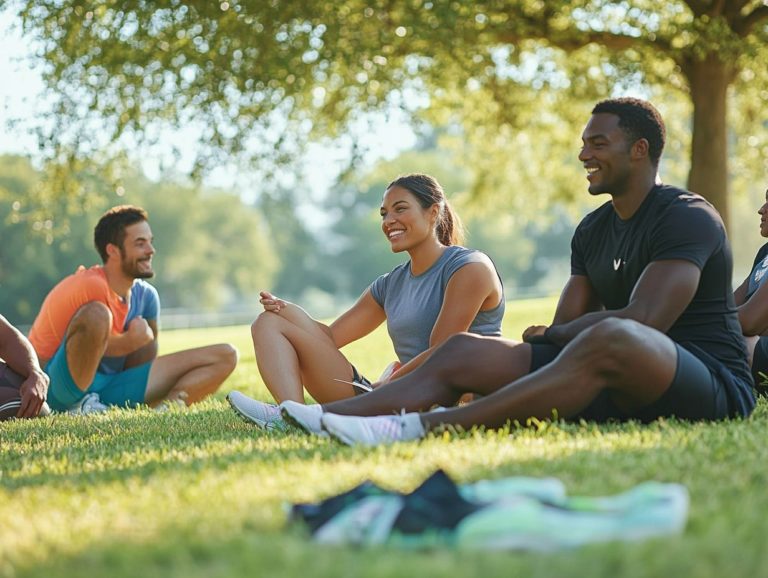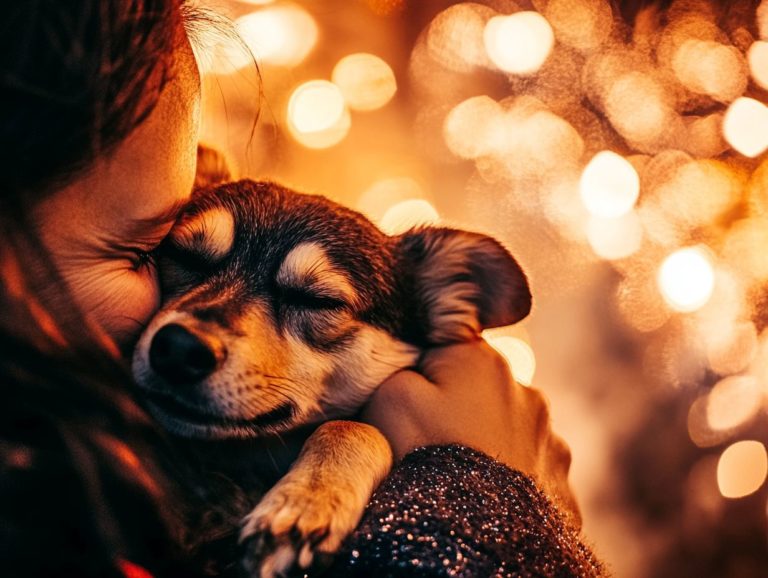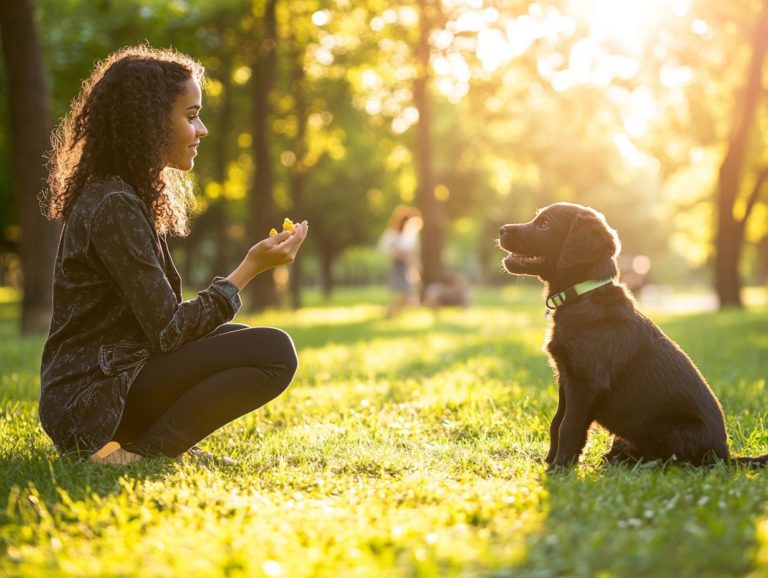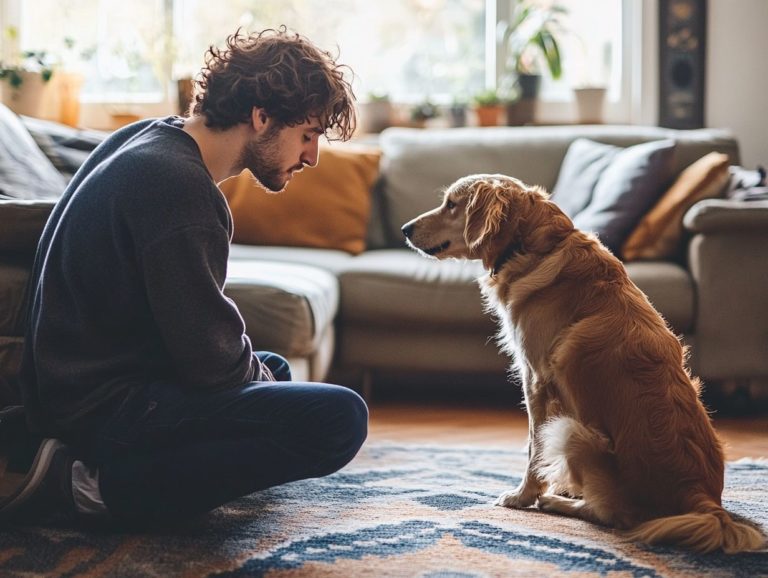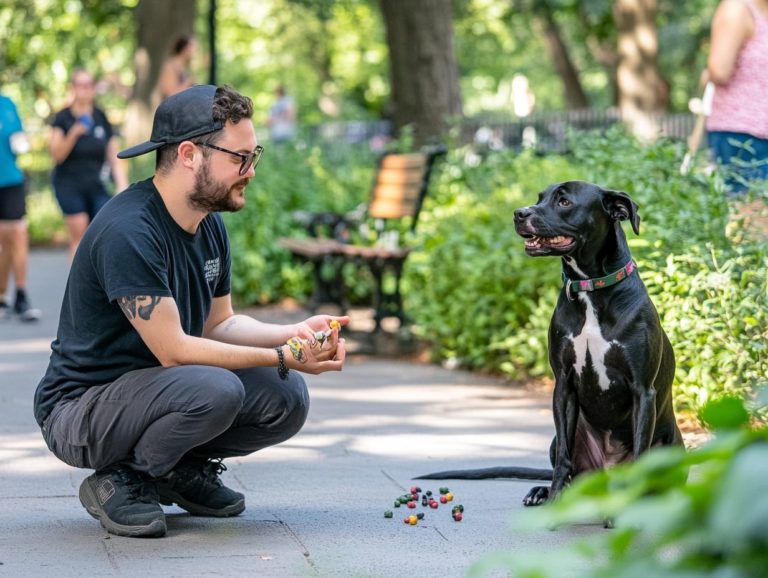Using Treats Effectively in Anxiety Training
Anxiety can profoundly affect your dog s behavior and overall well-being. Effective dog training is essential for their happiness.
This article delves into the power of treats as a formidable tool in anxiety training. It highlights the importance of positive reinforcement to inspire your furry companion, especially if they are fearful.
You ll discover everything from selecting the ideal treats to mastering the timing and techniques necessary for successful training.
We address common challenges and provide strategies for seamlessly integrating treats into a comprehensive training plan. This plan is designed for long-term success, taking into account the unique needs of dogs with anxiety.
Join us in transforming your anxious pup into a more confident companion! Build confidence through effective training methods!
Contents
- Key Takeaways:
- Anxiety Training for Dogs
- Benefits of Using Treats in Anxiety Training
- Types of Treats to Use
- How to Use Treats Effectively
- Potential Challenges and Solutions
- Incorporating Treats into a Comprehensive Training Plan
- Frequently Asked Questions with Expert Advice
- What role do treats play in anxiety training?
- How can I choose the right treats for my dog during anxiety training?
- Should I give my dog treats every time they exhibit a desired behavior during anxiety training?
- Can I use treats as a form of distraction during anxiety-inducing situations?
- What should I do if my dog refuses to take a treat during training to help dogs manage anxiety?
- Are there any alternatives to using treats in training to help dogs manage anxiety?
Key Takeaways:
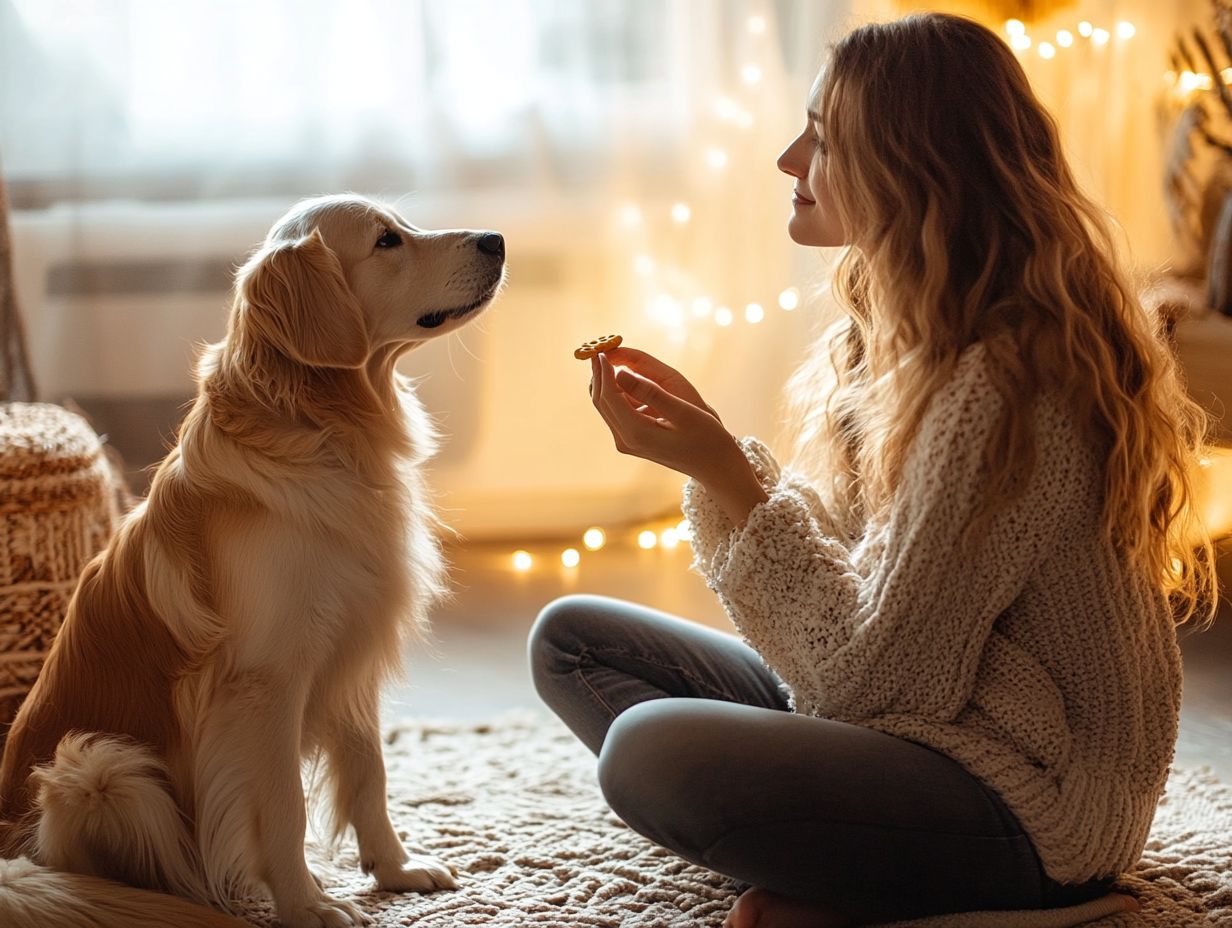
- Use treats as positive reinforcement in anxiety training to motivate your dog and reinforce desired obedience behaviors.
- Choose appropriate treats, such as high-value and small-sized options, to effectively reward and maintain your dog’s focus during training.
- Timing and techniques, like pairing treats with desired behaviors and gradually reducing their use, are key to using treats effectively in anxiety training.
Anxiety Training for Dogs
Anxiety training for dogs is a tailored approach designed to help fearful canines overcome their emotional challenges.
It focuses on understanding canine body language and stress signals.
This approach employs effective techniques rooted in contemporary dog training methodologies, such as positive reinforcement, gradual exposure, and transforming fear into positive experiences.
This process emphasizes recognizing early signs of anxiety and equips you with tools and strategies to foster confidence in your pet.
The goal is to cultivate a happier and more well-adjusted companion, enhancing the bond you share.
Understanding the Purpose and Process
Understanding anxiety training requires recognizing the root causes of canine anxiety.
Various training methods, like gradual exposure and transforming fear into positive experiences, can effectively address these issues.
For example, when your dog feels anxious due to loud noises or unfamiliar environments, it triggers a natural fight-or-flight response.
This often results in negative behaviors such as barking, growling, or hiding.
Through gradual exposure, you can help your dog build resilience over time.
This means exposing them to anxiety-inducing stimuli in a controlled way.
Transforming these distressing scenarios into positive experiences possibly using treats or praise is another effective method.
Together, these techniques aim to reduce anxiety while providing your dog with a sense of security, ultimately enhancing their overall quality of life.
Benefits of Using Treats in Anxiety Training
The advantages of incorporating treats into anxiety training stem from the power of positive reinforcement and effective food rewards. Additionally, using visual cues in anxiety training can further enhance the training process.
By utilizing training treats, you can enhance engagement and promote desired obedience behaviors in your canine companion.
Transform your dog’s anxiety into confidence today! Follow these steps and watch your furry friend thrive!
Positive Reinforcement and Motivation
Positive reinforcement is essential for motivating dogs during training. By offering immediate rewards such as training treats or praise, you can effectively strengthen the behaviors you want to encourage. This creates a safe learning environment.
This approach leverages basic psychology, showing that animals, including dogs, are more likely to repeat behaviors that yield positive outcomes. This understanding is particularly valuable when working with anxious dogs, especially those exhibiting separation anxiety. They often respond more favorably to encouragement than to correction.
By employing techniques like clicker training a method that uses a sound to mark good behavior or verbal praise, you can cultivate a safe learning environment where your dog feels supported. Over time, these consistent positive experiences can transform your dog’s emotional state, reducing anxiety and fostering confidence.
This, in turn, leads to more stable and consistent behavior, both during training sessions and in everyday life.
Types of Treats to Use
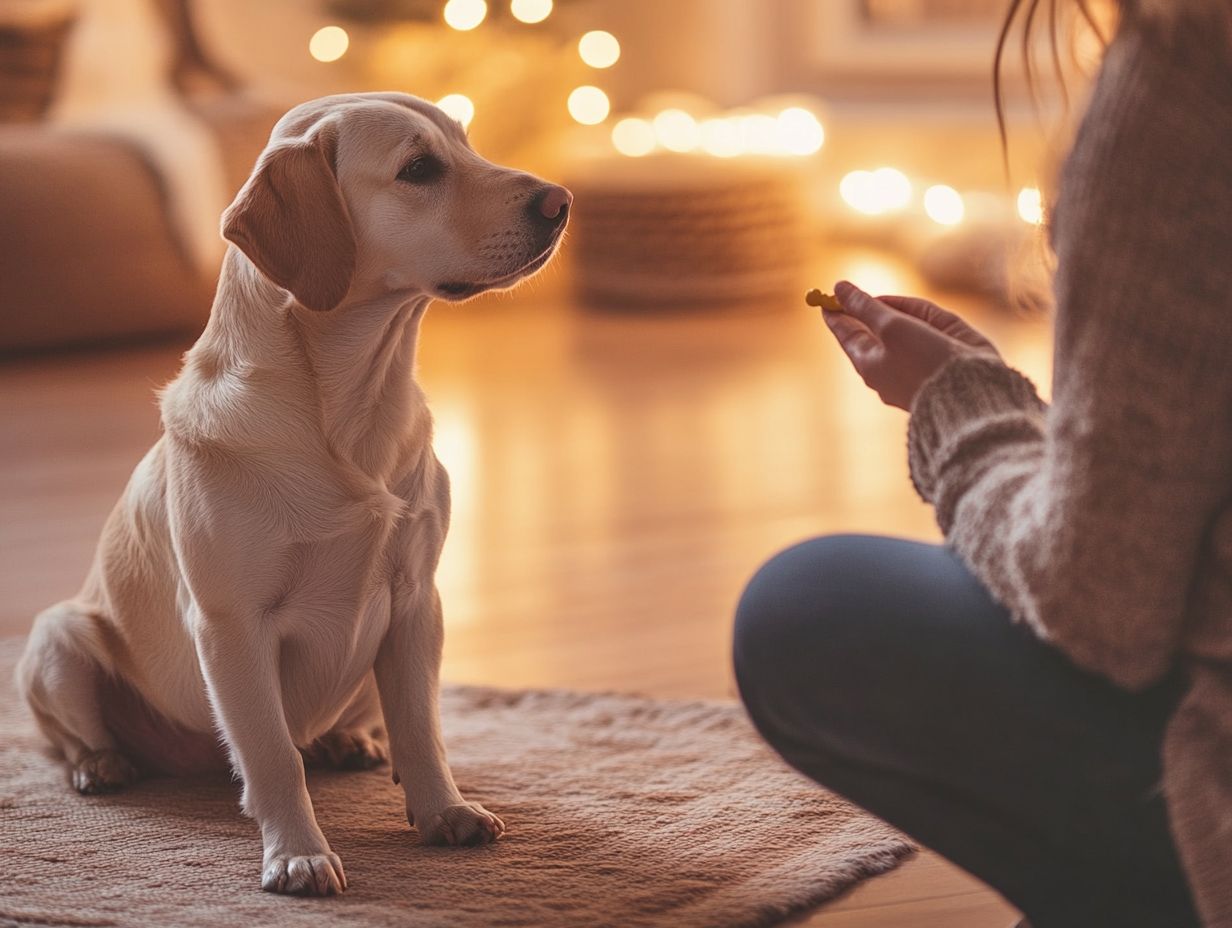
Selecting the right treats for anxiety training is crucial, particularly those that serve as effective calming techniques. These treats should be enticing to your dog and align with nutritional guidelines regarding caloric intake. This ensures they effectively function as food reinforcers while supporting your dog’s overall health.
Identifying Appropriate Options
Finding the right training treats for your dog requires understanding their individual preferences and sensitivities. This insight can significantly enhance the effectiveness of calming techniques during anxiety training.
Different dogs have their favorites when it comes to treats. Options can include treats from Quinn or specialized treat puzzles. You might find that your pup responds best to soft and chewy options, like tiny bits of chicken or cheese, while others may prefer the crunch of sweet potato snacks or biscuits. Pay attention to which treats elicit the most enthusiasm and engagement, recognizing their stress signals and canine body language. Notice those moments when their tail is wagging wildly or when they seem utterly captivated.
By offering a variety of treats during training sessions, you can pinpoint what truly excites your dog. Customizing your treat choices aligns with specific training objectives like rewarding calm behavior or reinforcing commands making the learning experience enjoyable and productive for both you and your furry companion.
How to Use Treats Effectively
Using treats effectively in dog training demands a strategic approach. Timing and clear techniques play crucial roles in maximizing their impact, especially when utilizing obedience training to ease anxiety. This ensures that desired behaviors are consistently reinforced during anxiety training sessions, making the process more rewarding for both you and your dog.
Timing and Techniques for Maximum Impact
The success of using treats in anxiety training hinges on your timing and the techniques you apply. You can reinforce positive behaviors while building trust between you and your dog.
When you utilize immediate reinforcement, you create a clear connection between the desired behavior and the reward. This is crucial for anxious dogs who can easily misinterpret cues. Changing reward patterns keeps your dog engaged longer, introducing an element of unpredictability that delights them and helps reduce anxiety.
Techniques like clicker training further enhance this process, allowing for precise communication of the actions you want to encourage. Act quickly and reinforce those great behaviors to see amazing results! By using a consistent marker sound, you can reinforce good behavior at the exact moment it occurs, effectively supporting your dog s learning curve and helping to diminish their anxiety over time.
Potential Challenges and Solutions
You may encounter potential challenges in anxiety training for dogs, often stemming from misunderstandings of canine behavior and a failure to recognize the signs of anxiety. You can tackle challenges head-on with the right solutions!
It becomes essential to implement effective solutions to navigate these obstacles successfully.
Addressing Common Issues
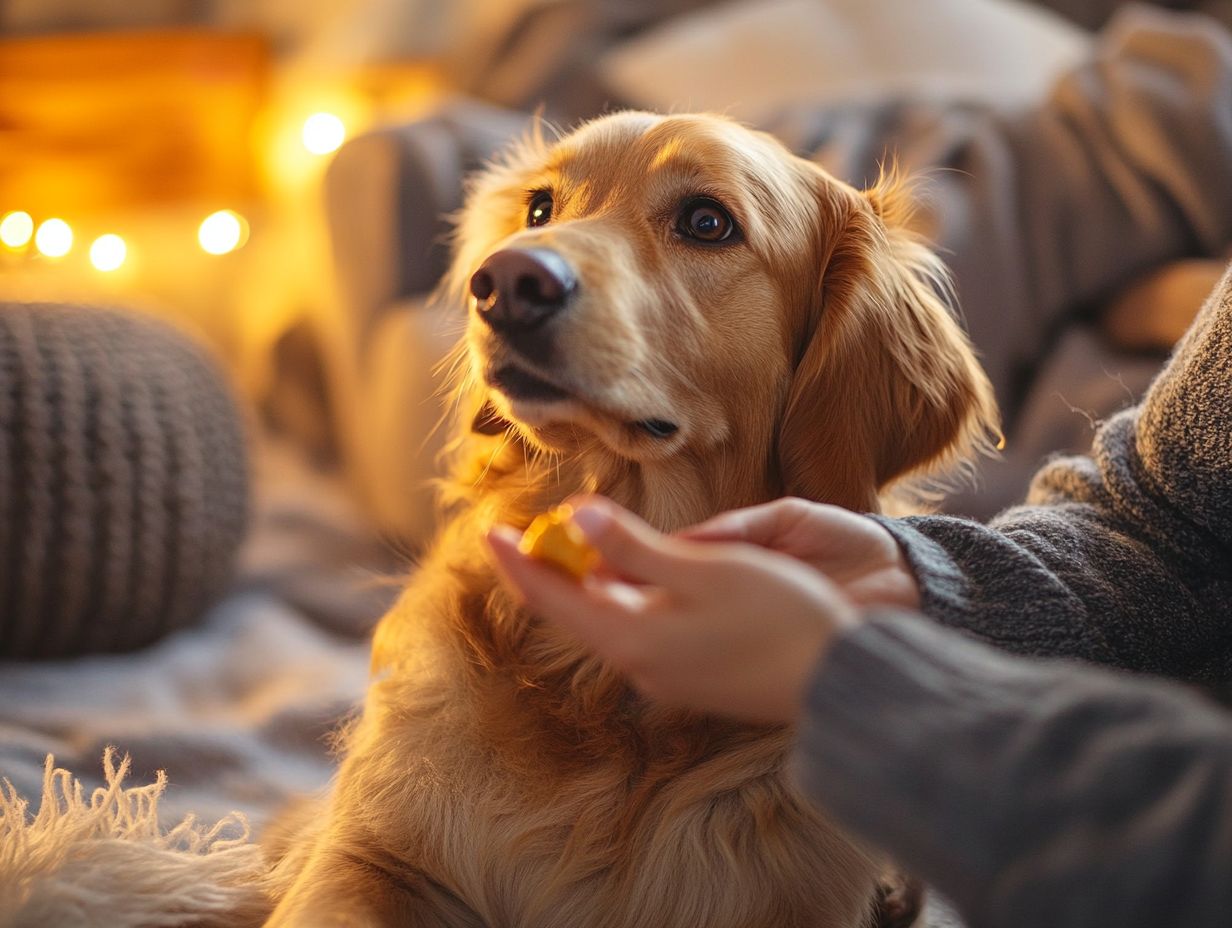
Addressing common issues in anxiety training requires you to recognize and respond to specific anxiety signs in dogs. This awareness allows you to adjust your training techniques and provide better support for the dog’s emotional state.
Take, for example, the significant challenge of a dog’s fear of loud noises. This anxiety often manifests as trembling or attempts to escape. It creates a distressing situation for both you and your dog. In these moments, you can use desensitization techniques by gradually exposing the dog to controlled sounds at low volumes, rewarding calm behavior along the way.
Another frequent issue is separation anxiety, where the dog becomes distressed when left alone. You can also implement gradual departures combined with positive reinforcement to help ease the dog’s discomfort.
By understanding these specific anxieties and applying targeted strategies, you can create a safe and loving environment for the dog. This ultimately enhances their emotional well-being and comfort, allowing for a greater bond between you and your canine companion.
Incorporating Treats into a Comprehensive Training Plan
Incorporating treats into your comprehensive training plan is essential for achieving long-term success and ensuring your dog remains engaged throughout the training schedule. This approach allows you to strategically reinforce obedience behaviors while effectively addressing the unique challenges that anxious dogs present.
Strategies for Long-Term Success
Strategies for achieving long-term success in anxiety training revolve around continually refining your techniques and incorporating insights from experts like Dr. Sophia Yin. These methods not only reinforce positive behaviors but also focus on instilling confidence in fearful dogs.
This approach demands a deep understanding of each dog’s unique triggers. It enables you to implement gradual exposure techniques that are both humane and effective, particularly for fearful dogs. Patience is paramount; it’s about celebrating those small victories while staying committed to the broader goal.
Consistency is key, reinforcing learned behaviors and creating a safe environment for the animals. You can tailor your methods to meet the specific needs of each dog, ensuring the training remains engaging and responsive to their emotional state. This fosters a stronger bond and promotes sustainable, positive behavioral changes in the long run, contributing to your dog’s happiness and well-being.
Frequently Asked Questions with Expert Advice
What role do treats play in anxiety training?
Treats act as positive reinforcement during anxiety training by rewarding desired behaviors and helping to create a positive association with the training process. Consulting a qualified dog trainer can also enhance this experience. Isn’t it amazing how treats can change your dog’s training experience?
How can I choose the right treats for my dog during anxiety training?
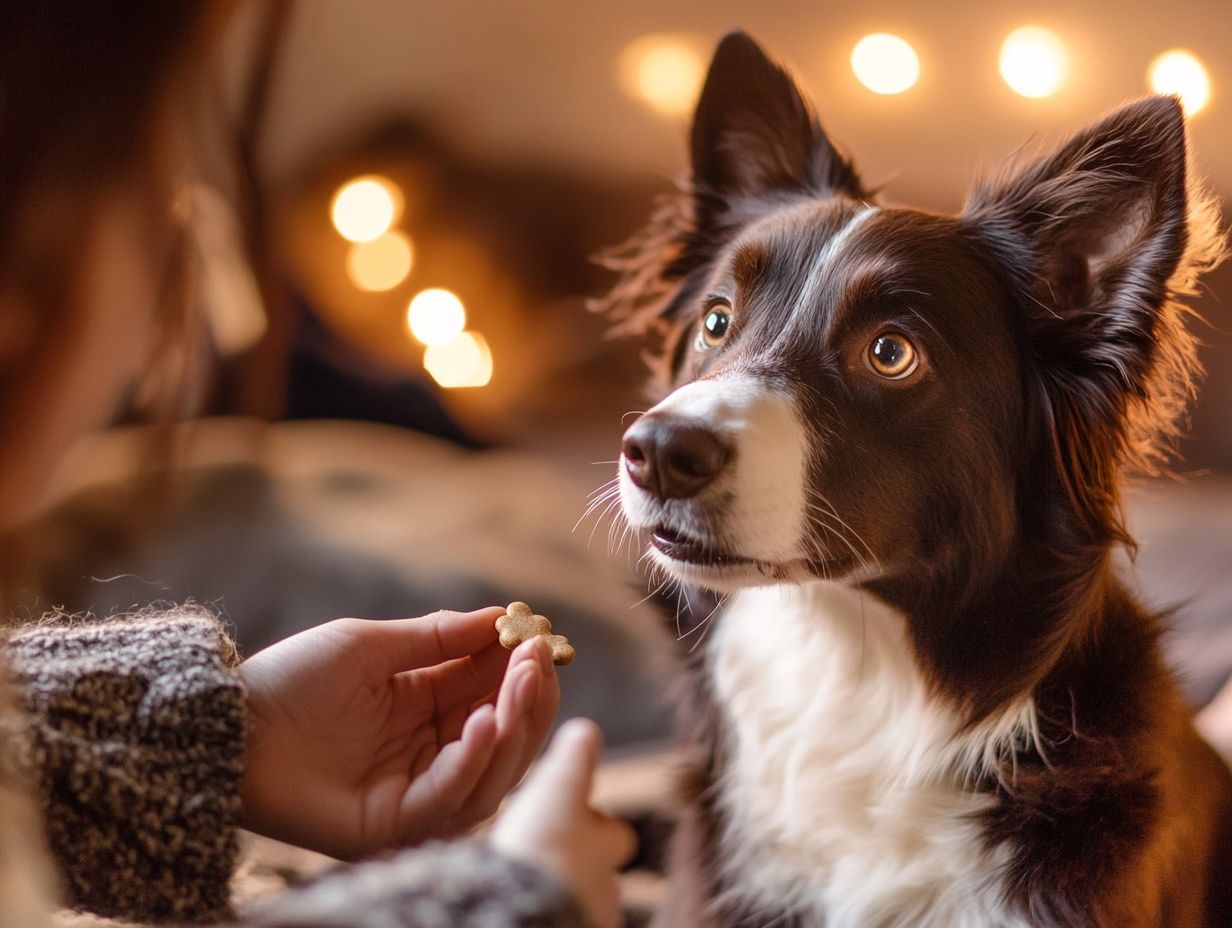
It is important to choose treats that are high-value and something your dog truly enjoys. This will make them more effective in motivating your dog during training. Resources like akc.org can guide you in selecting the right treats.
Should I give my dog treats every time they exhibit a desired behavior during anxiety training?
While treats are a great way to reward your dog, it is important to slowly phase them out and only give them intermittently. This prevents your dog from relying too much on treats. Incorporating techniques from Dr. Sophia Yin can also be beneficial.
Can I use treats as a form of distraction during anxiety-inducing situations?
Yes, treats can redirect your dog’s attention away from the anxiety-inducing situation and onto something positive. This can help your dog learn to cope with their anxiety more effectively, especially if you consider working with a behaviorist, a professional who specializes in animal behavior.
Act now and start training your dog today using the strategies discussed above!
What should I do if my dog refuses to take a treat during training to help dogs manage anxiety?
If your dog is too anxious to take a treat, it means they aren t ready for training. Respect their boundaries and try again later, perhaps after some fun agility exercises that help build confidence.
Are there any alternatives to using treats in training to help dogs manage anxiety?
There are other forms of positive reinforcement besides treats. Praise, toys, and playtime can work wonders! You can also use tools like a Treat and Train system to improve the experience.

